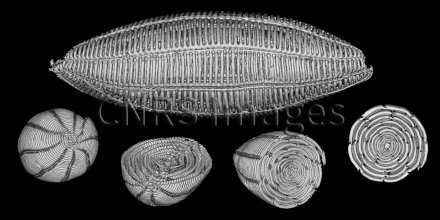Production year
2021

© Nathalie POULET-CROVISIER / Delphine DESMARES / Isabelle KRUTA / Marta BELLATO / CR2P / 2AD / MNHN / CNRS Images
20210137_0015
Foraminifera are single-celled marine organisms that have inhabited marine or brackish environments from the poles to the equator for more than 500 million years. When alive, they are remarkable bio- indicators of the state of our oceans since they are particularly sensitive to pollution. As fossils, their mineral shells enable palaeontologists to reconstruct past climates. Foraminifera make up one of the most abundant and diverse groups of fossils. This 2 mm-long alveolinid specimen was collected in the Paris Basin, and is over 40 million years old. It testifies to the presence at that time of a warm, shallow sea. When observed under X-rays, it reveals a complex internal organisation, with hundreds of tiny chambers, known as chamberlets, arranged in a spiral. This image is a winner of the 2021 La preuve par l'image (LPPI) competition.
The use of media visible on the CNRS Images Platform can be granted on request. Any reproduction or representation is forbidden without prior authorization from CNRS Images (except for resources under Creative Commons license).
No modification of an image may be made without the prior consent of CNRS Images.
No use of an image for advertising purposes or distribution to a third party may be made without the prior agreement of CNRS Images.
For more information, please consult our general conditions
2021
Our work is guided by the way scientists question the world around them and we translate their research into images to help people to understand the world better and to awaken their curiosity and wonderment.